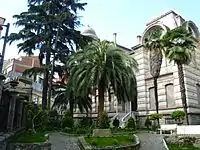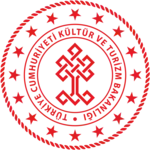Trabzon Museum
The Trabzon Museum (Turkish: Trabzon Müzesi), also known as Kostaki Mansion (Kostaki Konağı), is a historic house museum with archeological and ethnographic exhibitions located in Trabzon, Turkey.
Trabzon Müzesi | |
 | |
 Location of Trabzon Museum | |
| Established | April 22, 2001 |
|---|---|
| Location | Trabzon, Turkey |
| Coordinates | 41.00505°N 39.72657°E |
| Type | House museum, Archeological museum, Ethnographic museum |
| Collection size | 3,651 |
| Website | www.trabzonmuseum |
History
The mansion was built in the beginning of the 1900s as a private residence for Kostaki Teophylaktos, a notable banker of Greek origin.[1] It is known that the architect was of Italian origin and many materials used in the building were brought from Italy. However, the name of the architect is unknown.[2]
As Teophylaktos went bankrupt in 1917, all his properties were confiscated, among them his mansion. The building was acquired by the Nemlioğlu family.[2]
During the timespan of Turkish War of Independence (1919–1923), the mansion was used as the headquarters for the military in the region. In 1924, it was prepared for the first visit of Mustafa Kemal, the founder of the Turkish Republic, to Trabzon. Between September 15–17, he and the First Lady Latife stayed in the mansion.[2]
In 1927, the building was nationalized by the Governor of Trabzon Ali Galip Bey, and served until 1931 as the Governor's House. Between 1931-1937, it was used as the inspector's office.[2]
The Kostaki Mansion was assigned in 1937 to the Ministry of National Education, and was used for fifty years long as a vocational high school for girls. Finally, in 1987, the building was handed over to the Ministry of Culture and Tourism to be transformed into a museum.[2]
Museum
The building, one of the outstanding examples of the civil architecture in Turkey, was restored between 1988-2001. On April 22, 2001, it was opened to public as the Trabzon Museum. A total of 3,651 items are found in the museum's inventory.[2]
The building is on three levels in addition to a basement. The basement comprises archeological works, while the first floor is the section for ethnographic collections. On the ground floor, items belonging to the architecture and history of the mansion are exhibited. The attic is reserved for the administration.[2]
Archeological section
In this section, old coins and a wide range of items are exhibited, among them of marble, basalt, ceramic, metal and glas from Bronze Age (3300–1200 BCE), Classic stage (AD 250 – 900), Hellenistic (323-146 BC), Roman (753 BC-AD 1453) and Byzantine (330-1453) periods.[2]
Gallery
 Trabzon Museum Front
Trabzon Museum Front Trabzon Museum Front decoration of stairs
Trabzon Museum Front decoration of stairs Trabzon Museum Salon
Trabzon Museum Salon Trabzon Museum Dining room
Trabzon Museum Dining room Trabzon Museum Ceiling
Trabzon Museum Ceiling Trabzon Museum Glass panel
Trabzon Museum Glass panel Trabzon Museum Glass panel
Trabzon Museum Glass panel Trabzon Museum Glass panel
Trabzon Museum Glass panel Trabzon Museum Mosque door
Trabzon Museum Mosque door Trabzon Museum Detail of mihrab
Trabzon Museum Detail of mihrab Trabzon Museum Religious objects
Trabzon Museum Religious objects Trabzon Museum Cut shell
Trabzon Museum Cut shell Trabzon Museum Hermes statue
Trabzon Museum Hermes statue Trabzon Museum Hermes statue
Trabzon Museum Hermes statue
References
- "Müzeler-Trabzon Müzesi (Eski Kız Meslek Lisesi)" (in Turkish). trabzon.org. Archived from the original on 2010-06-20. Retrieved 2010-12-23.
- "Trabzon Müze Müdürlüğü" (in Turkish). Kültür ve Turizm Bakanlığı. Retrieved 2010-12-23.
- "Trabzon'un Abidevi Eserlerinden Kostaki Köşkü - Trabzon Müzesi (Kostaki Konağı)" (in Turkish). Kara Lahana. Archived from the original on 2010-12-18. Retrieved 2010-12-23.
